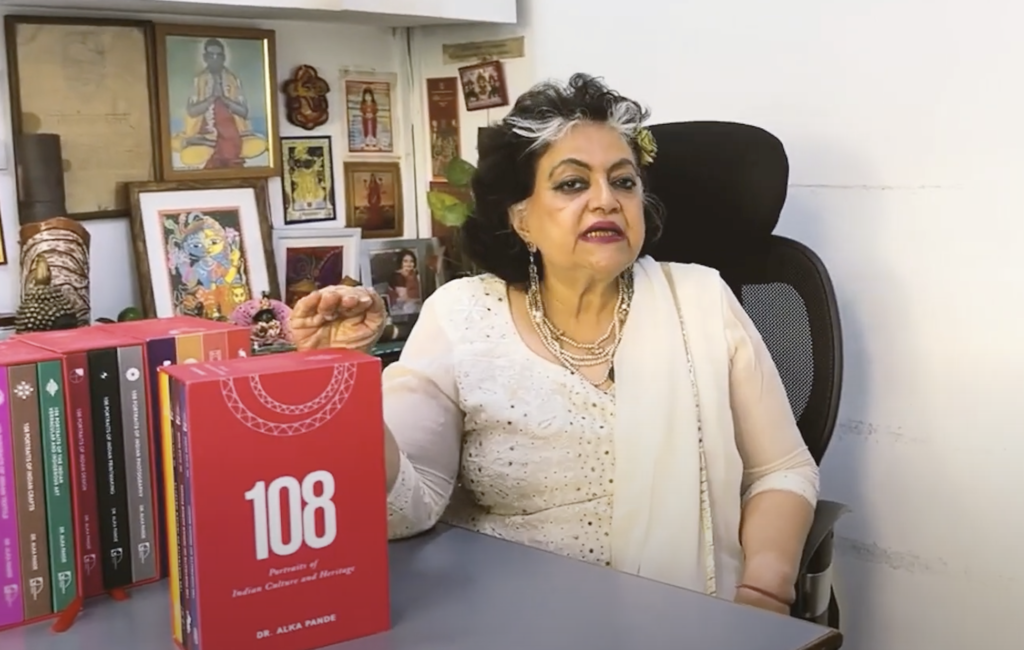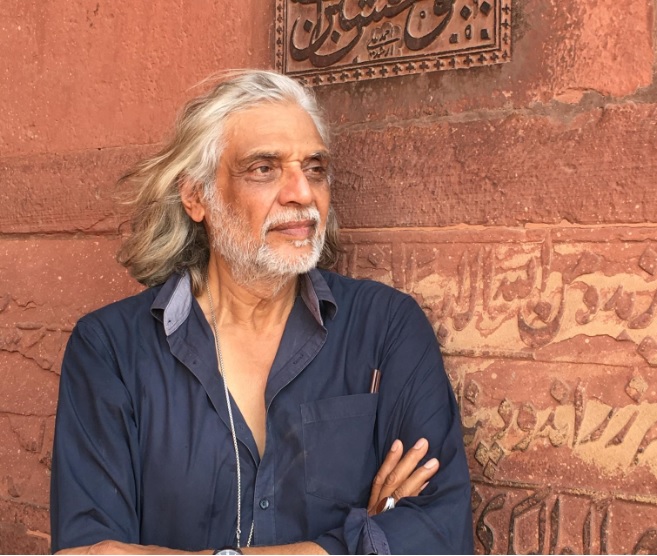Dr Alka Pande is an art historian who has taught Indian Arts and Aesthetics at Panjab University for over ten years. Her major interests include gender identity, sexuality, and traditional arts. She has received numerous awards, including the Knight of the Order of Arts and Letters, the Australian-India Council Special Award, and Chandigarh Lalit Kala Akademi honours to mention a few. Pande has also been involved in curating exhibitions and has been awarded the CIMA Lifetime Achievement Award 2023. She is currently the head of the Visual Art Gallery at the India Habitat Centre,New Delhi. Dr Pande also set up the Bihar Museum Biennale in 2021 and is now the chief curator for the Bihar Museum Biennale.
Recently Dr. Alka Pande released her monumental work, “108 Portraits of Indian Culture and Heritage.” This immersive collection of 14 collectable books, each exploring a distinct discipline such as art, architecture, objects, crafts, and more, showcases her dedication and expertise in the field of Indian art and aesthetics. Dr. Pande’s ability to encapsulate India’s rich cultural history, including illuminating art, architecture, and cultural landscape, while interweaving personal anecdotes, serves as a remarkable source of inspiration. Her work is not only lauded as an invaluable resource for scholars and enthusiasts but also recognised for its significant contribution to preserving and promoting India’s cultural heritage.
Nidheesh: Tell me about your curator work. You’re also heading it at this very important place in Delhi, the Habitat Center, and two to three galleries here. How do you see the current Indian art scene, and how does the world perceive Indian art? As we delve deeper into places like Patna, I notice the Jangarh book you wrote. New individuals are delving deeper into Indian art. How is this process unfolding, and how do you perceive it?
Dr Pande: Well, you know, actually, I see it as a whirlpool. There’s so much happening in India. And even though I’ve been completely dedicated to Indian art and culture, um, I’m overwhelmed. But while I’m overwhelmed, I’m really grateful that I’m there because, you know, you look at Hampi at one end, you look at Khajuraho on the other, you look at the Temple of Chidambaram near Pondicherry, you look at this whole area of the temples in Odisha in Bhubaneshwar, you go to every state, you go to, you’re overwhelmed. And this is just the built heritage. You look at the painting traditions, they are enormous by themselves. You’re talking of Junagarh, you’re looking at the folk and tribal art. So, India is literally a melting pot, a melting pot of ideas and what is happening.
When I observe what’s happening with contemporary artists, I see a veritable moving feast unfolding. India is brimming with talent; artists are creating wonderful things. There’s an exhibition at Bikaner House on Indigo, another on Textile Art. Siddhartha Das is presenting an exhibition on traditional imagery, drawing from his work designing museums and incorporating traditional methodologies into his design philosophy. India is truly a melting pot of creativity and ideas.
However, I believe young Indians need to turn the lens inward and draw inspiration from India itself, rather than solely seeking validation in Western gallery showings. While I understand the desire to be seen and recognised in the West, many Indian artists now prioritise international exhibitions like the Venice Biennale or the Tate Modern in New York. Yet, I believe one must first find balance and strength within themselves, rooted in their Indian identity, before conquering the world. Young Indians should immerse themselves in their own culture and environment. By understanding their own culture, whether Marathi or otherwise, they can then grasp the broader context of India and, ultimately, succeed globally. In today’s world, we must stand tall with pride in our multiple identities. Personally, I am a woman from Kumaon who grew up in Delhi—an urban woman, an art historian, a mother, and a professional. I embrace all these identities, but I find my greatest comfort in being Indian, particularly when navigating the Western world.
This same principle applies to the arts. We must be confident in who we are and what we create, without seeking validation from others. Have faith in yourself, and you will succeed.
Nidheesh: One, one of the things India has overwhelmingly contributed to the world is Indian erotica. You have extensively researched and documented this subject. When we look at the present times and compare them to the past, we see that erotica has been prevalent in various forms, including theater, sculptures, writings, and music. However, there seems to be a departure from this tradition, a distancing in the way we perceive it now.
Dr. Pande: you mean you look at it as taboo!
Nidheesh: I don’t view it as taboo; I’m merely observing that there’s a noticeable departure from the societal acceptance and ownership of erotica. In the past, it was pervasive, and the entire world acknowledged it, defining us in a way. However, presently, we seem to not embrace it with the same pride, sense of belonging, and delight as before
Dr. Pande: So, I rest my case. This is precisely what I was conveying. As artists, we must first take ownership. I’ve explored numerous interpretations and my own understanding of the Kamasutra. I curated a remarkable exhibition called ‘The Spiritual and the Erotic’ on the Kamasutra in Paris, which was wonderfully received by the city of love. However, would anyone dare to do the same in India? No, they would likely label it as pornography.
This misunderstanding stems from a lack of knowledge. The Kamasutra is not merely a manual of sexual positions; it consists of seven books, with only one focusing on such positions. The other six books delve into refined behavior, righteous living, and interpersonal relationships. They shed light on the esteemed position of courtesans in society—not as mere commercial sex workers, but as women of taste, knowledge, and agency.
Take Amrapali, the Nagar Vadhu of Vaishali, for instance. She was not viewed as a commercial sex worker but as an empowered woman of immense skill and agency. This was the reality of our ancient times. It was the influence of the British that introduced Western orthodox prudery. If you examine pleasure albums or temple facades, you’ll find depictions of various sexual acts, which were not viewed as pornography. These representations celebrated life and womanhood in all its facets. Today, places like Khajuraho are recognised as tributes to life and a celebration of women’s everyday activities, including the pleasure of sexual gratification.
In Hindu philosophy, Dharma (righteous living), Artha (material prosperity), Kama (sexual pleasure), and Moksha (liberation) are considered the four Purusharthas of life. Without a balanced approach to these aspects, how can one attain Moksha? The Hindu way of life is inclusive and evolved, and to diminish it by labelling it as pornography or commodifying women is a mark of an uninformed mind.
Nidheesh: I’ve always wondered about this as well, especially growing up near Khajuraho. The sheer scale and intricacy of these temples, stretching from Khajuraho to Konark and beyond, are astounding. How did such monumental works come to be over centuries, especially without modern technology, photography, or even paper for sketches?
It’s a fascinating question to ponder. We know about the individuals who commissioned these temples, but little is known about the artisans and artists who actually created these masterpieces. It must have been a highly collaborative effort, passed down over generations. I’ve often contemplated this aspect in relation to my own work. Creating something on a mammoth scale requires immense collaboration, skill, and dedication, much like the construction of these temples, so have you kind of worked around and thought about it?
Dr Pande: What I believe is that the human mind is truly remarkable, and the human imagination is boundless. We draw inspiration from the world around us—the nature, the here and now. Ananda Coomaraswamy beautifully describes this as the transformation of nature into art. For instance, when we read descriptions like ‘her lips were as red as a pomegranate’ or ‘her eyes were like lotus petals,’ we see how artists interpret and translate the world into their creations.
Stylistic development is another key aspect. Throughout history, we see different styles emerge, influenced by culture, period, and even physical characteristics. Take, for example, the Nagar style temples, with their distinct manifestations and canons, reflecting the period and culture they belong to. Similarly, Chola temples in Tamil Nadu exhibit a different physical representation, influenced by the cultural and physical attributes of the Tamil people.
The same applies to the Konark temple, where the faces depicted resemble the local Oriya women. Kangra paintings, too, reflect the beauty of the women and milkmaids of the region. Artists drew inspiration from their surroundings, creating gods and goddesses in the image of man and the most beautiful women they observed.
Moreover, the spirit of the times, or zeitgeist, plays a crucial role. Take, for instance, the Didarganj Yakshi—a sculpture that mirrors the beauty of Bihari women. The artist’s inspiration stemmed directly from the women he saw around him. Each artist’s interpretation was unique, influenced by their aesthetics, knowledge, and understanding of the world around them.





